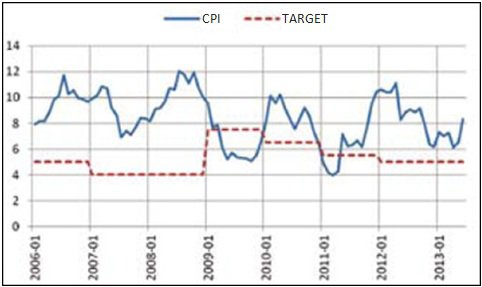A challenging period concerning inflation
The CPI has not converged with the headline inflation unlike what is normally expected. Headline inflation has long ago lost its function as a “headline” indicator.
The period ahead will be challenging for Turkey concerning not only growth but also inflation. The initiation of the monetary tightening process in the US puts an upwards pressure on the currencies of emerging market economies including Turkey. It appears that this pressure will be here with us for quite a long period. This does not mean that it will be a permanent challenge, though. The exchange rate might have ups and downs and fluctuations occasionally. Given the volume of the quantitative easing operation the FED has carried out since the beginning of the global crisis, however, the main exchange rate trend will be upwards. And please note that the increase in exchange and interest rates in the past two months took place in response to the declaration that the easing process will gradually be cut and halted, not that it will be withdrawn. Following this process, the liquidity will (partially?) be withdrawn and the policy rates will be gradually increased. Therefore, we are talking about quite a long timeframe. We may add the recent hikes in crude oil prices up on the list as well.
On the other hand, it would not be possible to claim that Turkey’s inflation performance is on track even if the FED launched the tightening operation at a later date. There has been a permanent discrepancy between inflation realization and targets. For instance, CPI average since 2004 stands at 8.4 percent. There is no significant difference when we look at a shorter timeframe. The average CPI since 2006 is exactly the same. If we take it from 2010, we see that average CPI inflation is only slightly lower, at 7.9 percent. The CPI for June is 8.3 percent, also close to longer-term average.
The headline inflation (l indicator) that is frequently quoted does not give us a relief, either. True, headline inflation is lower than the CPI inflation. June figure was 5.6 percent, for instance. But that’s the very problem, actually. The indicator which is expected to give insights about the inflationary outlook and called the “headline” inflation for this very reason does not actually serve this purpose. It has been lower than the CPI since 2006 except a few months, and the difference has somehow not changed. In other words, the CPI has not converged with the headline inflation unlike what is normally expected. It is most likely that the headline inflation has long ago lost its function as a “headline” indicator. Headline inflation averaged at 6 percent since 2006 and at 5.7 percent since 2010 and in the last eight months.
We can best illustrate to what degree the CPI converged with the target by using a graph. The one below shows annual CPI realizations and targets since January 2006. I think this is worth a thousand words.

Figure 1: CPI realization and targets: January 2006 – June 2013 (%). Source: TURKSTAT
This commentary was published in Radikal daily on 11.07.2013




